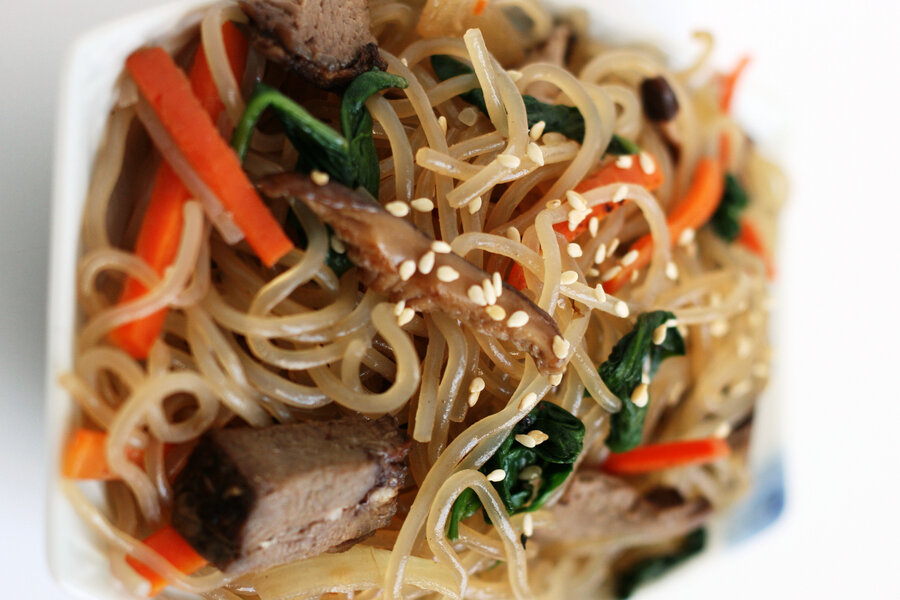By Patricia Tanumihardja, Pickles and Tea
Stir-fried glass nboodles (Japchae)
Makes 6-8 servings
Japchae is often a co-mingling of noodles and an assortment of vegetables and meat. My recipe uses only vegetables but feel free to add your choice of protein. I’ve sliced up leftover sirloin steak, and barbecued pork (about 1 cup) and tossed them in with the noodles. Sweet potato noodles are sold at Asian markets. If you can’t find them, substitute the fattest mung bean/cellophane noodles available and follow the package directions to cook.
1 pound dried Korean sweet potato noodles
Hot water
8 ounces spinach, trimmed (4 to 5 cups)
2 tablespoons vegetable oil, plus more as needed
6 medium dried black mushrooms, rehydrated and cut into thin slices (3/4 cup)
1 small yellow onion, halved and cut into thin crescents
2 medium carrots, peeled and cut into matchsticks (1-1/4 cups)
3 green onions, white and green parts, cut into 1-inch lengths
2 cloves garlic, minced
1⁄3 cup soy sauce
3 tablespoons brown sugar
1 tablespoon sesame oil
1 tablespoon toasted sesame seeds
1. Place the noodles in a heatproof bowl and soak in hot water for 15 minutes.
2. With kitchen shears, cut into 3- to 4-inch pieces. You just want the noodles to be manageable so don’t worry about getting exact lengths. Drain and set aside.
3. Place the spinach in a heatproof bowl and soak in very hot water for 1 to 2 minutes until wilted but not fully cooked. Rinse under cold running water and drain. Gently squeeze the water from the spinach and cut into 3 sections.
4. Preheat a large wok or skillet over medium-high heat for 1 minute. Swirl in the oil and heat until it becomes runny and starts to shimmer. Add the mushrooms, onion, carrots, green onions, and garlic and stir and cook until the carrots are crisp tender, 2 to 3 minutes. Reduce the heat to medium and toss in the noodles (here’s where you add precooked meat if you’d like).
5. Add the soy sauce, brown sugar, and sesame oil. Stir everything swiftly around the wok for 3 to 4 minutes, coating the noodles evenly with the seasonings. Add more oil if the noodles stick to the bottom of the wok. Taste and adjust seasonings if desired.
6. Mix in the spinach and sesame seeds at the very end and toss with a couple more flourishes. Serve hot or let cool to room temperature.
Note: Japchae keeps well and can stay fresh for up to a week in the refrigerator. To reheat, cook in a skillet and add sesame oil until the noodles are supple and heated through.
See the full post on Stir It Up!








